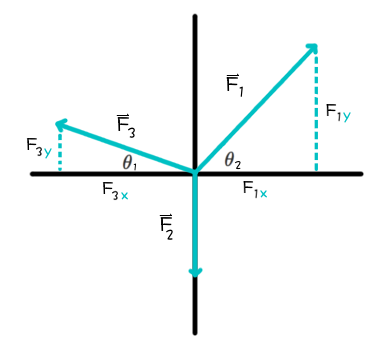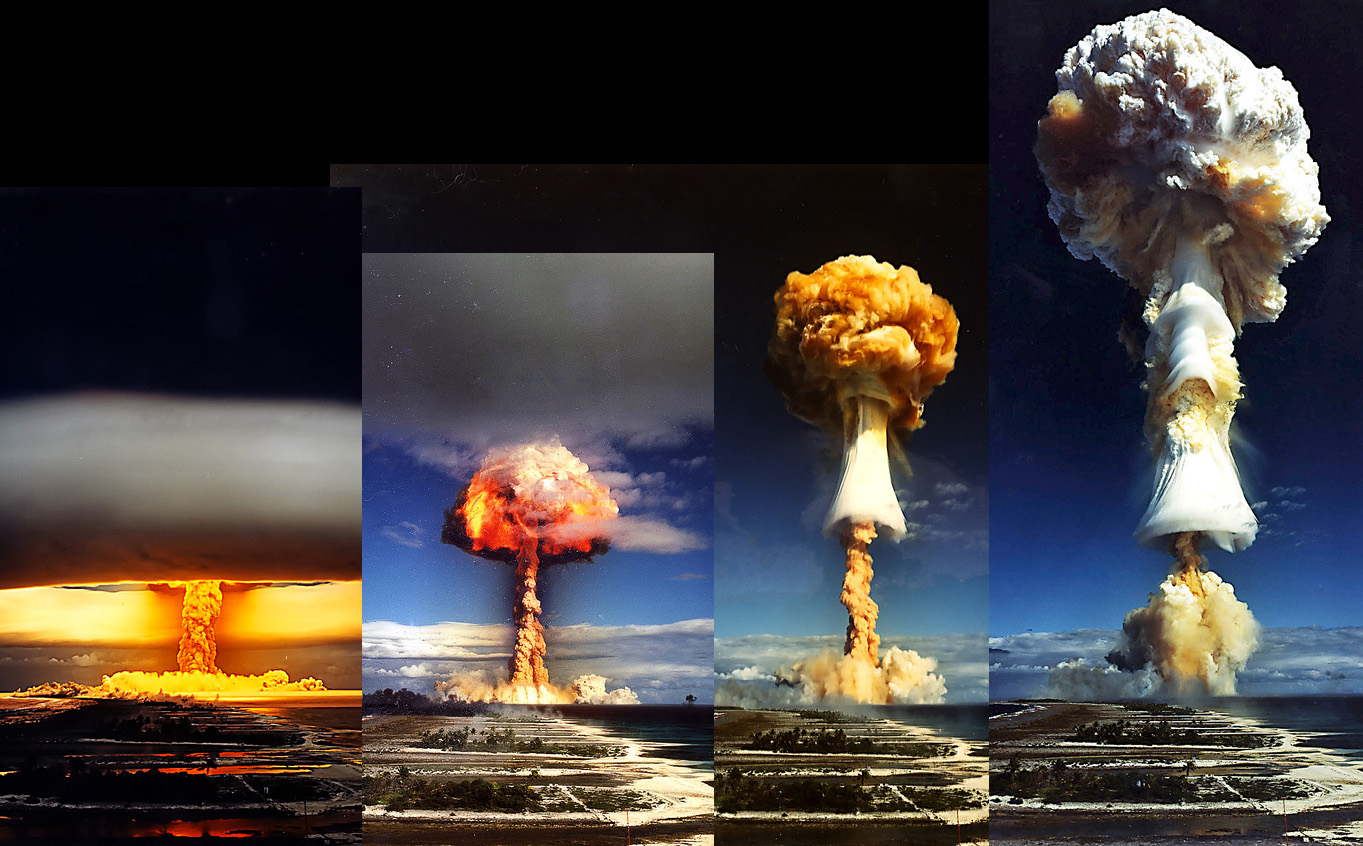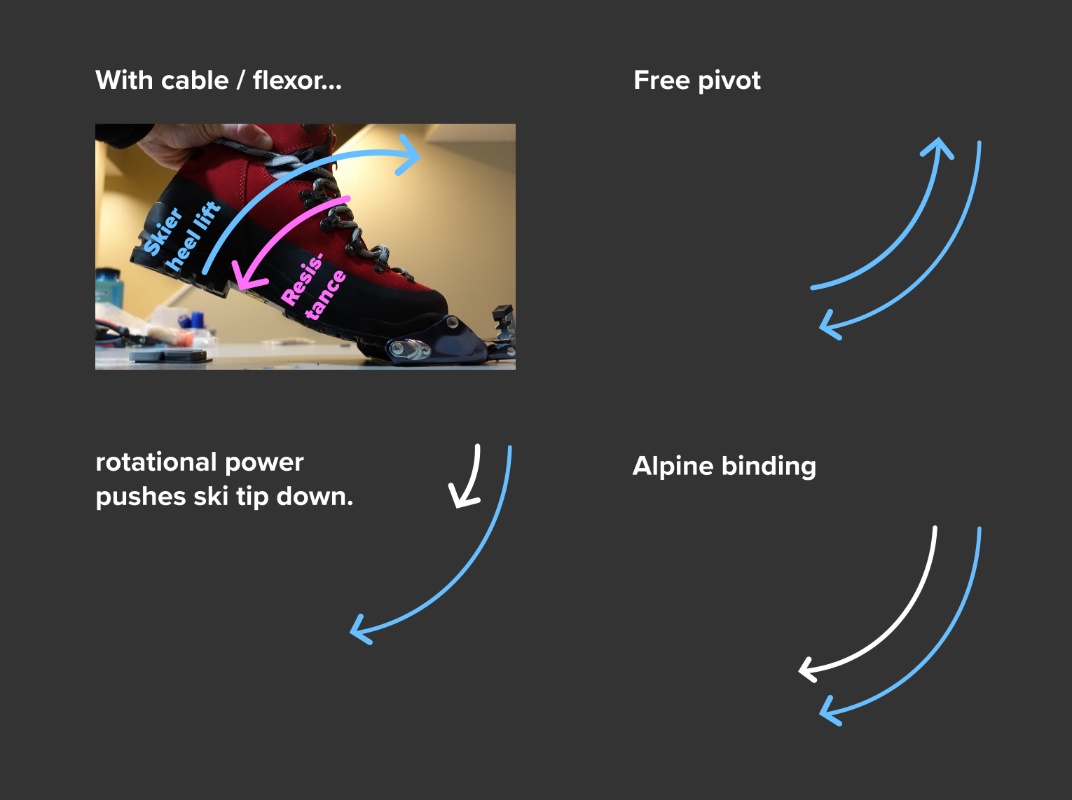Pictures below!
Terms like "Force", "Energy", and "Power" have specific definitions in Physics, as well as layman usage that is not the same (e.g. "Theory" of gravity is not same as "I have a theory of where I left my car keys). If this helps...
Stephen wrote: ↑Tue Jan 10, 2023 8:44 pm
STRICTLY speaking, cables to not CREATE force. They do TRANSMIT force, which is what I belive you mean, and is what I UNDERSTAND you to be saying.
Or
STORE it under TENSION and even COMPRESSION (think of springs). More below...
GrimSurfer wrote: ↑Wed Jan 11, 2023 10:00 am
...cables don’t create force. ... Things are still hung up the transmission of force ... [some contend] a cable, attached to itself through a plate (of sorts) can transmit
additional force. The cable is in tension. [IF... the] force that it creates in one direction (against the heel) is equal to the force it receives in another (against the cable by the plate) ... the net force is zero.
... differing arcs of the cable-plate and boot-plate creates variable tension throughout a range of motion.
If it helps people, BALANCED FORCES (gravity, active, tension, compression, ... whatever you like to think) result in NO CHANGE of VECTOR (direction and speed) ala momentum -- if stopped it stays stopped, and if moving it continues along its course.
However, UN-BALANCED FORCES result in a change of speed and/or direction.
There are also different Frames of Reference if you will, in that the skier can remain fixed, immobile like a statue, yet acted upon by the skis (via bindings, etc.) hitting a bump. A CLUSTER of things (skier-binding-ski) can remain in balance within that group, yet change their interface with the slope/snow to effect a change in speed and/or direction.
DG99 wrote: ↑Wed Jan 11, 2023 2:36 am
I’m a biologist. And a telemark skier at times. Definitely will say that the the cable creates force that pressures the tip of the ski! So to speak!!!.

"Creates" or "stores" force? Think of a spring. Lying on the counter it does not just expand nor contract on its own. However, if a force acts on it (Active Force from a human's muscle), and then contained by a metal casing of sort (wall of which are under Tension, equal in measure to the spring's Compression) and the only way for the spring to apply "force" is for the Tension to fail or be released, and in turn the spring can release it's stored energy (potential --> kinetic) which will not exceed that which the human's muscle imparted, less when losses due to things like heat and friction are accounted for.
As for "cable ... pressures the tip", I'd lean more toward something like "spring force (potential energy) acting through a pivot to exert force tangent to the pivot (rubber bumper thingie) through a lever (ski) where it makes contact (snow) with an opposing force (Earth) ..." and "if the cable is not a radius of the pivot or connects off-center of it, a 'triangle of forces' may or may not be 'in balance'."
GrimSurfer wrote:*Please don’t say that the cable is in motion on its own. It isn’t because it doesn’t possess any energy.
It can 'store' it -- Potential Energy, similar to flywheels, etc.
An issue I see is...
... the term "force" is being used when there are different kinds, just as there are different "vehicles", so a lack of clarity leads to ambiguity, confusion, and conflict, same as if one person's "vehicle" is a car, the next one's is a truck, a third is thinking motorcycle, fourth a submarine, etc.
So... for expediency I'm going to lift from
this page for the following...
Contact Forces
Frictional Force: the force exerted by a surface as an object moves across it or makes an effort to move across it (e.g. sliding friction, static friction, rolling friction, fluid friction, air see below, ...)
Normal Force: the support force exerted upon an object that is in contact with another stable object, Fnorm
Air Resistance Force: a special type of frictional force that acts upon objects as they travel through the air
Applied Force: applied to an object by a person or another object, Fapp
Tension Force: the force that is transmitted through a string, rope, cable or wire when it is pulled tight by forces acting from opposite ends
Spring Force: the force exerted by a compressed or stretched spring upon any object that is attached to it [I prefer to just use the terms Tension <- -> and Compression -> <- as a spring can do either]
(Khan Acadamy has a tutorial on "What is tension?" including some free body diagrams.)
Action-at-a-Distance Forces
Gravitational Force: the earth, moon, or other massively large object attracts another object towards itself, Fgrav = m*g, "weight*
Electrical Force: [see next]
Magnetic Force: [look up Electro-Magnetic force sometime, and be happy there isn't a thread about it here... yet]
[You may have also heard of
Weak and
Strong forces with regard to atoms, and that's a level I think we can skirt here]
Example: An airplane in steady flight has four Forces in balance...
Gravitational Force pulling it DOWN --
in balance with -- Lift (resultant force from different air pressures above/below wing due to different speeds of air over wing) pushing it UP
and
Thrust (similar to Lift ala pressure, but via various methods) pulling it FORWARD --
in balance with -- Drag (Air Resistance Force) pulling it it BACKWARD
 This article
This article points out some
incorrectly illustrate as all FOUR being equal, when in fact it is
opposed pairs*.
This may seem trivial until one realizes changing your speed, while it affects LIFT , does NOT change GRAVITY.
This is key for pilots as they have to adjust lift via wing controls flaps and surfaces to maintain level flight when "speed" changes.
* It's also possible for three
or more forces in opposition to be balanced,
and we haven't even gotten past two- to three-dimensions!

Diagrams get more complex when an airplane climbs or dives (much less "turns") with this one showing Center of Gravity and Center of Lift ...
 And then there's Energy's relationship with Force(s)...
Energy can be (as well as change between)...
Potential*: stored
And then there's Energy's relationship with Force(s)...
Energy can be (as well as change between)...
Potential*: stored
Kinetic*: moving, movement, momentum, ...
Thermal: heat
Electrical: pet your cat backwards sometime
Chemical: ala gasoline
Nuclear:
this thread?
(* the two most pertinent to this thread, IMO)
Same event, different points in time. (Can you spot the skier?)


I get the gist here, yet there's something in the color consistence, arc depictions, and forces (as in if in a Free Body Diagram ... FBD) I rub my chin over, part of which is their isolation from the ski and ground which play a part, part is the variety of cable routings leading to more than one fulcrum being involved in a FBD with varying locations creating different levers-within-levers, but I've wrote enough as is.
There was a cool short video of an anchor bolt in a block of glass/plastic that when tension was applied to the bolt, the block appeared unchanged. However, when redone with light passing through the block, one could see the distortions in the light pattern passing through to a wall made by the tension -- evidence of an "equal and opposite" reaction, usually un-observable to the human eye.
Courtesy mention
@lowangle al @tkarhu @TheMusher @wabene @lilcliffy as recent contributors for a general FYI/FWIW.




